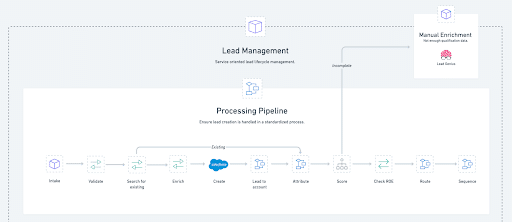
Your revenue operations team can reliably get inbound leads into the hands of your sales representatives in roughly two minutes, executing every step of your lead management process along the way.
Fast and reliable lead routing is extremely important for lead management.
Delays in your revenue processes, especially in lead follow-up, decimate funnels. Slow lead processing makes it 7x less likely you’ll ever qualify your leads. Most RevOps pros understand this, but lead management is a deceptively complex set of processes, oftentimes built on the back of a house of cards.
Consider the overall “jobs to be done” of the lead lifecycle:
- Lead Intake – Capture a lead from a given source (e.g., website forms, live chat, list uploads, Ad vendors, etc…)
- Validation – Ensure an email is valid before allowing it into any system of record
- Creation – Create leads in the system of record if there are not any existing records for the prospect already
- Enrichment – Programmatically enrich data required for routing or accurate scoring. Send those still missing important data to manual enrichment
- Lead to account match – If lead belongs to an existing account in system of record, associate to account
- Attribution – Give credit to programs driving engagement for each touch
- Scoring – Apply a score using demographic, firmographic, and behavioral attributes
- Routing – Check rules of engagement for a prospect in order to route appropriately (e.g., round robin, direct assignment, etc…)
- Sequencing – Start sales outreach asap
Note: If you haven’t heard of “Jobs to be done,” check it out, it’s worth a read.
Oftentimes these jobs are done asynchronously using a myriad of third-party tools, which despite everyone’s best intentions, leads to challenges with the reliability and speed of lead processing. These challenges are especially difficult for those on the front lines to troubleshoot.
Problems with orchestrating processes across multiple tools aren’t limited to lead management, either: If you work in RevOps, you’ve certainly earned some battle scars when trying to make the litany of software tools across your go-to-market org play nice.
On the one hand, the proliferation of SaaS means teams across the organization can find best-in-class solutions for their use cases. On the other hand, there are unintended consequences when adopting them, and dealing with that normally falls on the shoulders of ops. Likely, you’ll spend countless hours dealing with the various quirks of these tools, collectively increasing your technical debt more and more as time goes on.
Meanwhile, only the most well-resourced teams can allocate engineering resources to build homegrown solutions that resolve these issues. But nobody gets off easy. This approach has its own challenges. You must also account for the overhead homegrown has in terms of ongoing maintenance and adapting to changes as your go-to-market strategy evolves.
The reality is most of us heavily rely on purpose-built tools and native integrations from our SaaS vendors of choice. No matter how much your team has invested in technology, we still must deal with its inherent limitations. Maybe you’re spending too much time on manual processes (such as list imports), answering an onslaught of messages from teammates regarding data discrepancies, fighting endlessly to squash out duplicates, or filing too many vendor tickets trying to understand what’s happening inside the black box.
The bottom line is these gaps turn into roadblocks that cost your company serious money. The pain is even more apparent in a challenging economy, where tight budgets mean you’re expected to justify ROI while your budgets get frozen, if not cut. Here’s the harsh truth, 58% of business professionals say less than half of their applications have netted a positive ROI. Meanwhile, 66% of marketing teams don’t believe they have the skills to use their existing technology effectively.

Ouch. Let that sink in. Do you have any idea how much money we’re spending on software here, folks?
Chin up. Don’t worry. There’s hope! The fact is, this is all POSITIVE. There’s SO much room for improvement here if you work in RevOps. It’s a great opportunity you can solve.
Everybody loves the RevOps hero.
The future of revenue ops
Considering how hard it is to manage the revenue stack, it’s no accident leaders are radically rethinking their approach to better support their company’s revenue strategy. Instead of taking a “tools first” approach and designing around limitations, smart teams opt for a process-driven approach, choosing open, API-first systems to fit into their stack.
Process-first thinking isn’t new: we’ve always wanted to do things this way. We’ve just lacked the resources and tools to deliver.
But friends, the times, they are a-changin’! The lines between engineering and operations are blurring as practitioners are becoming increasingly technical. They’re learning to leverage APIs to connect systems, write SQL to query data warehouses, and use JavaScript to instrument tooling. Building technical skills open the door for operations pros to be truly process-driven by integrating, orchestrating, and automating processes across your go-to-market organization, such as lead management. And how are they putting these technical skills into practice?
By learning to leverage General Automation Platforms (GAP) like the Tray Platform. These automation platforms close the resource gap for semi-technical ops professionals, empowering them to build multi-step, automated processes called “workflows.” These workflows focus on the job to be done first, not the technology vendor that does it.
Introducing RevOps frameworks: Lead management
Throughout this series of posts, we’ll introduce a workflow framework that makes sure the lifeblood of your sales pipeline is in good, strike that, GREAT health.
Using a lead management framework built on the Tray Platform provides your team with control and visibility into every possible aspect of your lead funnel. You can quite literally measure your funnel’s reliability and speed at every step. Meanwhile, you will prepare yourself for a future in which Citizen Automators (that’s you) build processes tailor-made to your organization’s needs, without ever having to worry again about whether your software tools “do that” or wait for engineering support.
The Foundation: A lead processing pipeline workflow
At the center of this framework is a workflow we call the “Lead processing pipeline.” The pipeline is responsible for orchestrating each of the essential lead management jobs to be done. From intake to creation to enrichment and beyond, you can use this process for any lead, no matter the source.

Before getting too deep into the framework, we wanted to introduce our process-driven approach and explain why we believe this approach is a smart choice that unlocks new possibilities for RevOps teams.
We host a series of deep dives into each of the workflows supporting the framework on the Tray.io blog if you’re interested. We delve into the nitty-gritty details, so you’ll have a practical guide to building your very own lead management process on the Tray Platform. You can also get your hands dirty by requesting a trial of the Tray Platform here.
The post Why automation is the future of lead management (and RevOps) appeared first on Search Engine Land.
No comments:
Post a Comment